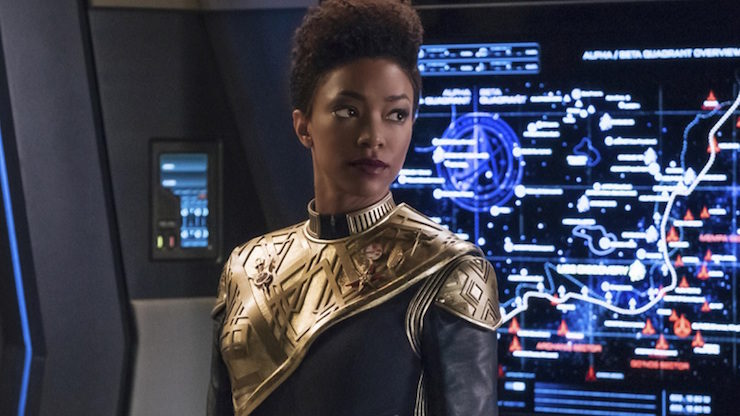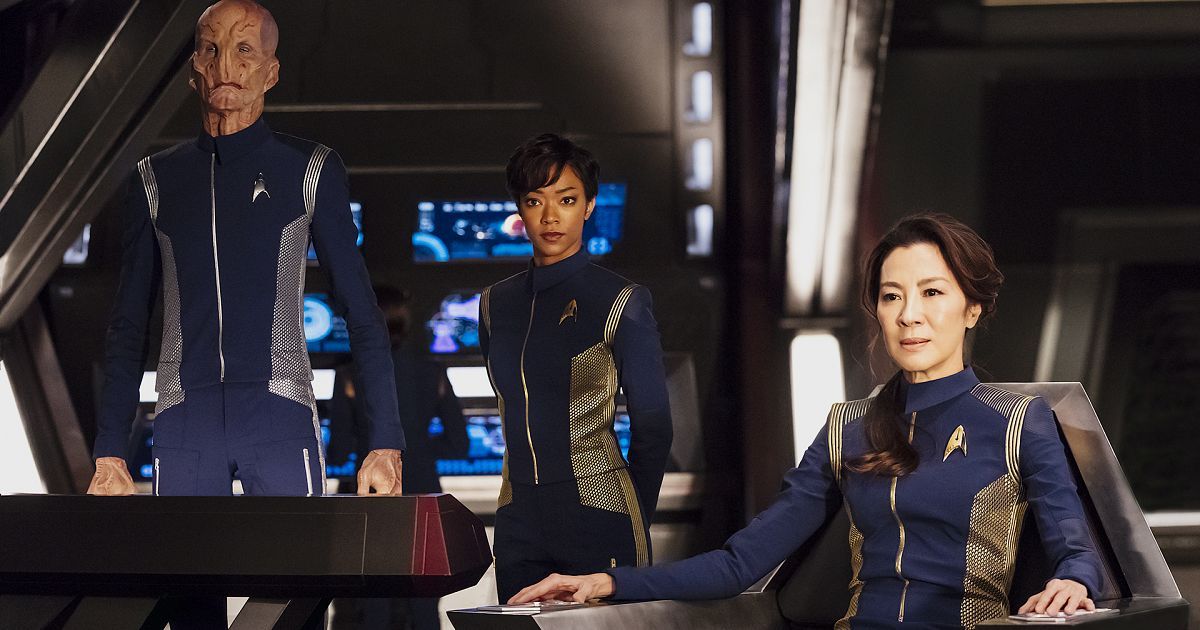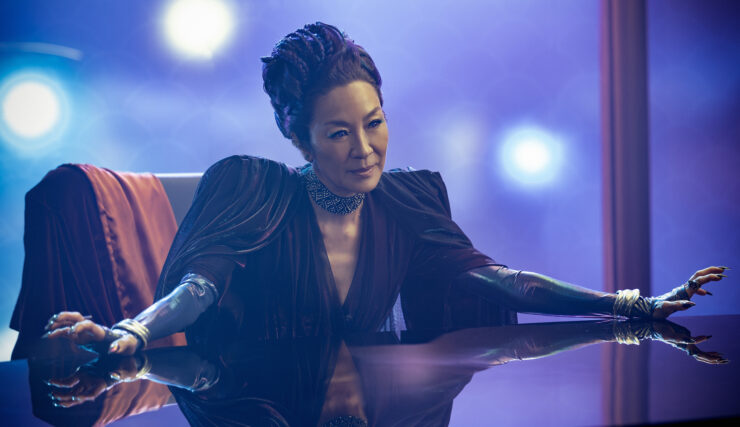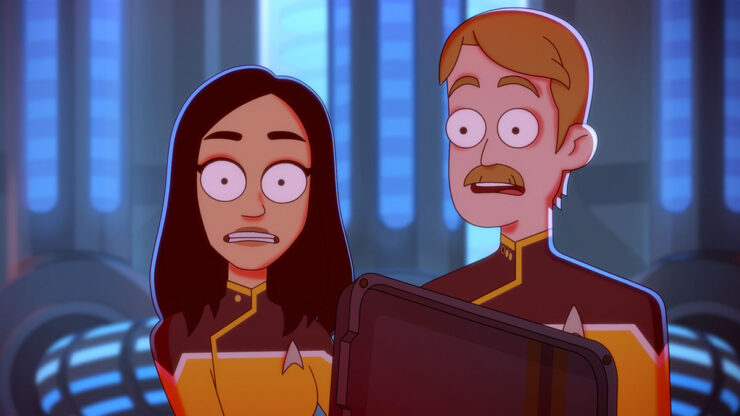“I dunno,” the Star Trek fan says with a sigh. “I mean, the uniforms are all monochrome, I feel like the timeline’s all messed up, they’re just rehashing stuff they’ve done before, it all feels so military with the metal insignia, and they’re killing characters off, and it just all doesn’t feel like real Trek, y’know?”
This Trek fan is, of course, from 1982 and complaining about The Wrath of Khan.
Yes, I can do this all day.
But I won’t. Instead, let’s look back at a most uneven first season of Star Trek Discovery
This season has been a spectacular mix of really great and really wrong, crowning moments of awesome right alongside incredible head-scratchers.
There are five particularly frustrating elements of the show: two decisions that did significant damage before an episode had even aired, a third that showed a disconnect between how the show was written and how it was released, a fourth that probably sounded good in the planning stages but was a disaster in execution, and a fifth that was wrong-headed and completely avoidable.
The first was to set the show in the twenty-third century. As I said last week in my review of “Will You Take My Hand?” I don’t give an airborne intercourse that the set design and tech don’t look the same as they do in the original series. However, there are some people who do, and their opinions as viewers count, too. Yes, there are good reasons why they didn’t just mimic the tech the way they did in “Relics” and “Trials and Tribble-ations” and “In a Mirror, Darkly,” and I think they made the right choice given the initial decision to set the show ten years prior to TOS.
What I question is the need to set the show ten years prior to TOS. Why open the can of worms? Why not just do what The Next Generation did so well thirty years ago and jump the timeline forward? Yes, the last two iterations of the franchise—Enterprise and the Bad Robot movies—looked backward instead of forward. But that yielded the only one of the Star Trek TV spinoffs to fail in the marketplace, one hit movie, one hit movie that was not as well received, and one box-office flop. Moving forward, on the other hand, yielded three successful series that all ran seven years and ended on their own terms instead of being cancelled. Prequels are not the best model to choose, is what I’m saying, at least in this franchise. (Maybe it’s something about a space opera starting with “Star”…)
There’s absolutely nothing in the overall storyline of Discovery that requires it to be in the twenty-third century. Yes, it would require a war between the Federation and the Klingons after their alliance in Star Trek VI: The Undiscovered Country, but a lot can happen in a few decades’ time. Heck, the Federation-Klingon alliance went from solid to sundered to back together again just within the seven years that Deep Space Nine was on the air. Why not move ahead fifty years from the end of the Dominion War and have the Klingon-Federation alliance long shattered (maybe over the aftermath of the destruction of Romulus that was established in the 2009 film, with irreconcilable differences growing out of how to treat what’s left of the Romulans)? Over the years, the Klingon Houses have collapsed into in-fighting and T’Kuvma tries to unite them by sending them to war against the Federation, blaming the Federation alliance for everything that’s wrong with the empire. Yes, jumping the timeline means the Mirror Universe segments need to be either much different or trashed all together (though “Parallels” gives us the out of it being a different parallel timeline that isn’t the MU) and losing Sarek and Amanda and Harry Mudd, but I’m okay with excising those fannish indulgences. Yes, some good things were done with those elements (Captain Killy, the Vulcan Science Academy retcon in “Lethe”), but they were none of them crucial to the season, in my opinion. And the mycelial network and spore drive can be brand-new technology that you don’t have to come up with a reason to never have been mentioned again in any of the twenty-five seasons’ worth of episodes and ten movies that take place after this show. (Something they still haven’t done, by the way.)
Shoulda coulda woulda. We’re stuck with the 2250s timeframe now, so not much use crying about it (not that that’s stopping me or anyone else…).
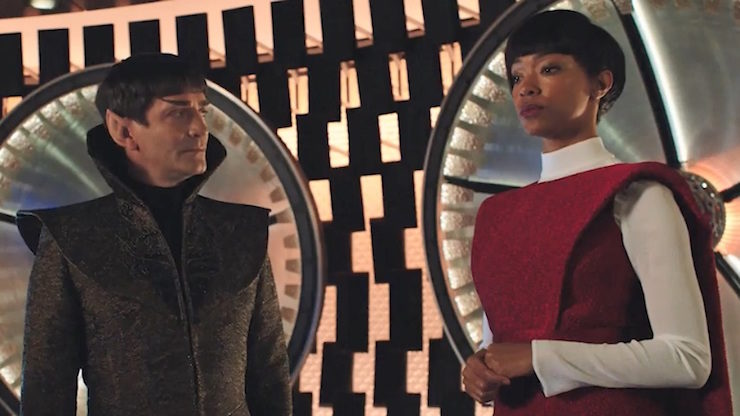
The second issue was not actually starting the season at the beginning of the story, but instead with a mediocre prologue. Star Trek Discovery’s story actually starts in “Context is for Kings.” What happens in “The Vulcan Hello” and “Battle at the Binary Stars” is backstory that is good to know about in detail eventually, but not critical to get first. The season is about Michael Burnham clawing her way back to respectability. Also, the show is called Star Trek Discovery—starting off with two episodes that have nothing to do with your ship is off-putting, especially when those are the episodes you want to use to draw people to your fancy-shmancy new streaming service.
And just from a storytelling perspective, it would’ve been far more effective to be introduced to Burnham post-disgrace. Watching her being ostracized by Saru, by the Discovery crew, but Lorca giving her a chance. We would be given hints as to the awful thing she’s done, all the way up until Burnham gets the telescope that Georgiou bequeathed her at the end of “Choose Your Pain.”
After that, after Burnham watches the affectionate recording that Georgiou made for her, after seeing how badly it affected her, then we could see “Vulcan Hello”/”Binary Stars” as a flashback two-parter to provide the backstory. By then, we’re invested in Burnham, in Saru, in Lorca and Tilly and Stamets, and even in Georgiou thanks to her message to Burnham. Then we find out how this whole shebang started, and the clunky awkwardness of the scripting in the two-parter would have been leavened by having seen three good episodes prior to it.
The third problem is one that shows a disconnect between how the show was released and how it was written. These fifteen episodes were very obviously written in much the same way all the other streaming services’ original series are, in a serialized manner meant to be watched in a big chunk all at once. But the show wasn’t actually released that way, with CBS still clinging to the old once-a-week release schedule, complete with a mid-season hiatus. As a result, the hints that Lorca was from the MU and that Tyler was actually Voq were decried as predictable by an audience that had months to speculate about it. What was truly foreshadowing was criticized as being obvious because the viewership had too much time between episodes to chew on things.
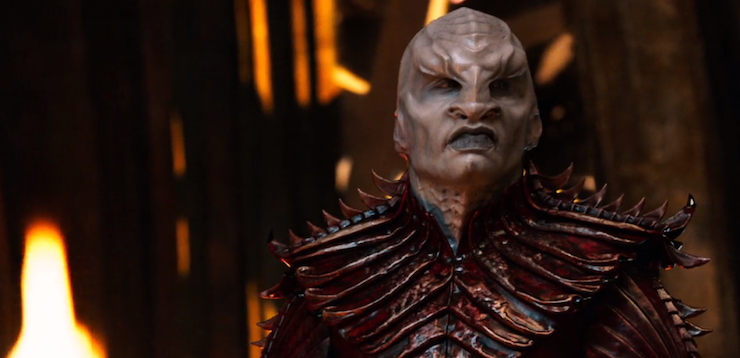
The fourth problem was one that I mentioned several times in my reviews, and it never really got any better, as it was as big an issue in the finale as it was in the premiere. I appreciate that the Klingons only spoke their own language among themselves in theory. In practice, it was a disaster, as actors already slathered in latex have to wrap their lips around a nonexistent language that is very heavy on harsh consonants. Every time there’s Klingon dialogue, the whole episode grinds to a halt; it takes so long for the actors to speak their lines, you have time to read the subtitles twice.
And finally, they killed off Culber. This death was not redeemed as many had hoped, certainly not by the cheesy Stamets-talks-to-Culber’s-ghost scene in the mycelial network in “Vaulting Ambition.” Star Trek has generally been at the forefront of being progressive in speculative fiction on television. As an example, the number of SF TV shows where the primary lead is a person of color is vanishingly small, numbering less than half a dozen—but two of them are Trek shows (Discovery and DS9). However, they’ve repeatedly dropped the ball on non-heteronormative relationships, either half-assing it (“Rejoined“), botching it (“The Outcast“), or actively pretending such things don’t exist (“The Host“).
At first, Discovery changed that, giving us a wonderful relationship in Stamets and Culber, but then they decided to succumb to the oh-so-tiresome trend of killing off a gay character, which is not a section of TV Tropes you really want your show to be in.
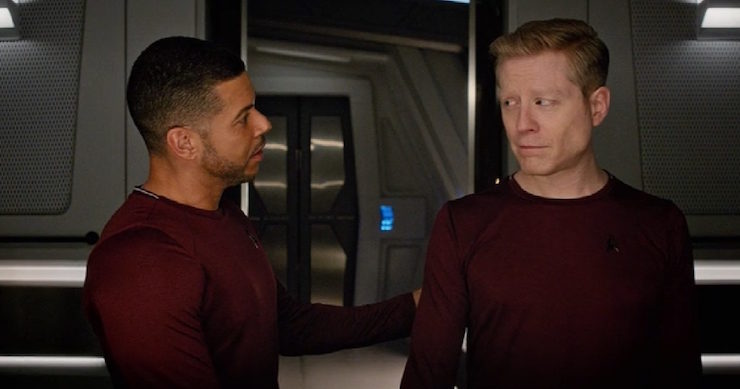
There’s a certain lack of rhythm to the show’s story progress, which may be the result of the behind-the-scenes tumult going from a show run by Bryan Fuller to one run by Aaron Harberts & Gretchen J. Berg, and just in general, the show has about eight hundred and seventy-four people whose credit is “executive producer,” which is not always conducive to coherence…
Having said all that, the show has the one thing that characterizes Star Trek, he says punningly: the characters. In Burnham, Saru, Stamets, and Tilly, we have a core set of characters that are interesting, that have grown, that are fascinating (sorry…), and that are worthy successors to the core characters of the past five shows, from T’Pol, Tucker, and Phlox on Enterprise to Kirk, Spock, and McCoy on the original series to Janeway, Seven of Nine, and the EMH on Voyager to Picard, Data, and Worf on TNG to, well, everyone on DS9.
Burnham is a strong lead, a person who has an inherent nobility of purpose, but who also is, to quote her foster brother, a mass of conflicting impulses, as she struggles with the balance between logic and emotion, but coming at it from the opposite direction as Spock. Stamets is a delight, going from snarky and obnoxious—a scientist, a man of peace, trapped in a war effort—to the hippy-dippy engineer, as exposure to the mycelial network opens up the possibilities of the universe to him. And Tilly is a goofy-ass diamond in the rough whom we see being honed into a strong officer (hooray for Captain Killy!), but still one who has a ton to learn (like when to stop talking).
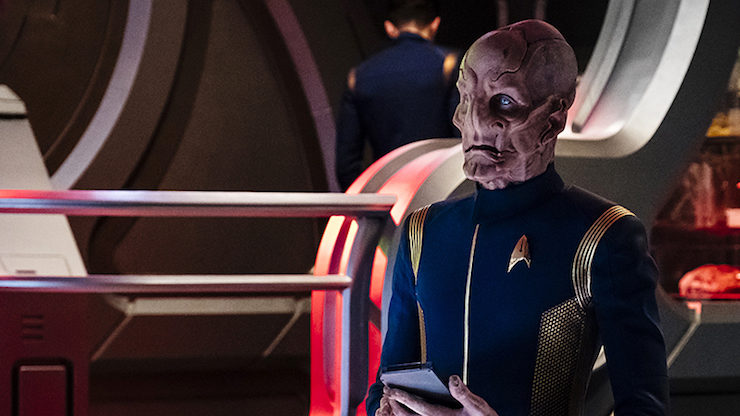
Then we have Saru. I gotta say that even if I liked nothing else about Discovery, I would think the show was worth it because it gave us Doug Jones’s magnificent character. Saru is quintessential Star Trek: noble, unsure of himself, complicated, heroic. The concept of his species is a fantastic one, and many of the season’s best moments come from Saru. There’s his reading of Lorca and Tyler’s escape from the Klingons to figure out that the captain and future security chief are there, using his instincts as a prey animal, in “Choose Your Pain.” There’s his stirring speech after Lorca’s duplicity is exposed about how it’s their ship in “What’s Past is Prologue.” There’s his “we are still Starfleet” speech in “The Wolf Inside.” There’s the compassion he shows to Tyler in “The War Without, the War Within” and prior to that, the expert way he manipulates L’Rell, playing on her love for Voq, but also refusing to accept her chest-beating about war in “Vaulting Ambition.” There’s his using a bizarre form of the scientific method to help guide him as acting captain, which he then abandons when he realizes that comparing himself to the likes of Georgiou, Decker, and Pike isn’t the way to do it, also in “Choose Your Pain.” And there’s his entire arc in “Si Vis Pacem, Para Bellum” where he gets his heart’s desire and has it yanked away from him.
Even though the overall story didn’t always entirely work, there are individual sequences that did so very nicely, above and beyond the various great moments Saru had (particularly in the final batch of episodes). The solution to Mudd’s Groundhog Day time-looping in “Magic to Make the Sanest Man Go Mad” was beautifully handled, and done so in a manner that provided spectacular character development for both Stamets and Burnham. (And we got to see Lorca killed multiple times!) The action scenes—never among Trek‘s strong suits in the past—were actually all very well choreographed, from the two fights on the sarcophagus ship in both “Battle at the Binary Stars” and “Into the Forest I Go” to Lorca’s rebellion on the Charon in “What’s Past is Prologue” to Emperor Georgiou tormenting L’Rell in “Will You Take My Hand?”
Unlike many, I do not find the revelation that Lorca is a nasty bad guy to be a disappointment. The argument—and it’s a good one, simply one I disagree with—is that Lorca went from being a nuanced complex Starfleet officer who maybe was pushing the envelope of the right thing to a mustache-twirling villain. The thing is, the mustache-twirling villain was always there, he was just lurking under Jason Isaacs’s charm and his attempt to fit into the strange universe where he didn’t belong.
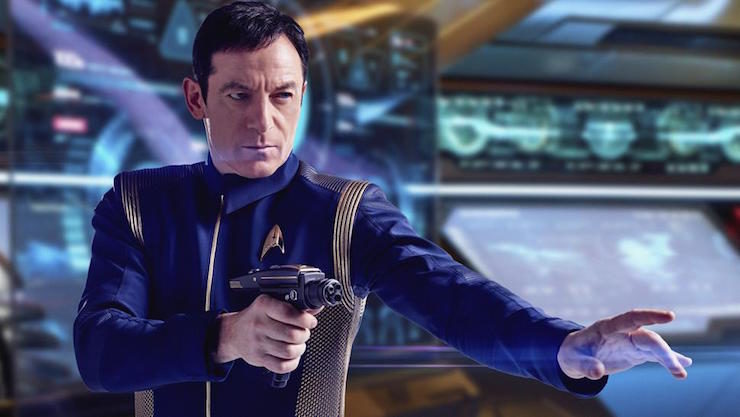
But this is a person who left Mudd behind, who left Cornwell to be kidnapped by Klingons, who showed absolutely no evidence of sympathy for the tardigrade, and who generally was an asshole. And often evil hides behind a charming facade. The cliche about the serial killer whom everyone thought was such a nice person is a cliche for a reason.
Another complaint was that Lorca was too kind to Burnham because she looked like his co-conspirator in the MU—the thing is, they even foreshadowed that and everyone missed it. Landry was an idiot, a racist, and an incompetent. It never made sense that she would be the security chief on a starship, and she died incredibly stupid. But it does make sense if Lorca mentored her because she looks just like his lieutenant in the MU, as established in “What’s Past is Prologue.” That’s Lorca’s fatal flaw, his attachment to people in one universe or another based on their counterpart, which led to Landry dying stupid by being put in a position she should never have been in, and Burnham surviving to help stop Lorca because Lorca thought she would be like his Burnham.
The plot didn’t always cohere properly, and they didn’t spend enough time on all of their plotlines, and the resolutions were a bit too pat, and some of the plot choices were seriously odd. On the other hand, we have a great set of characters, we have had some strong suspenseful situations, some excellent character arcs and character journeys, and powerful action. The special effects are, of course, great, and the overall look is distinctive and compelling, and there’s nary a bad performance in the bunch, as the cast, from the regulars to the guest stars, having ranged from very good to out-of-this-world (er, so to speak) great. Sonequa Martin-Green leads the ensemble spectacularly, her intensity and capacity for facial expressions serving her well and helping her cement Burnham’s rather unique place among Trek leads.
The elements are all there for a great show, they just need to get the story structure a little better in place.
Keith R.A. DeCandido was at a convention with Sonequa Martin-Green this past weekend and got to give her an autographed copy of his book The Klingon Art of War. She proceeded to totally nerd out over it and geeble about how she was going to bring it to the set. Keith is inordinately pleased with himself over this.










